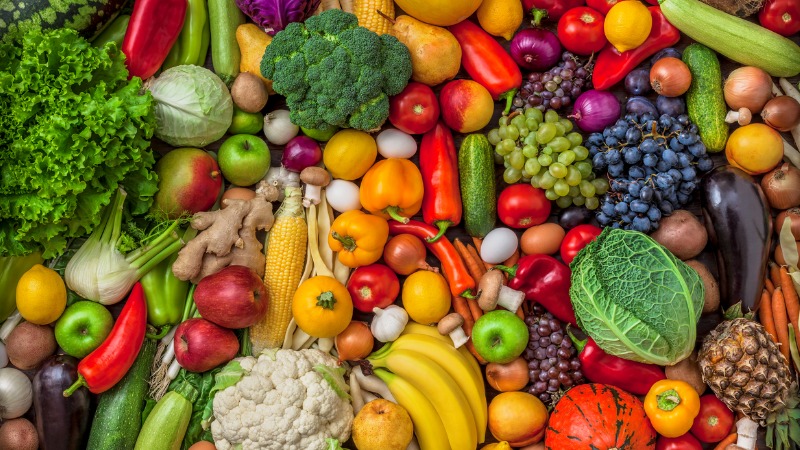Fruit and vegetables in Albania

Current situation and production trends during the period 2015-2019. With more than 2 million tons produced in 2019, horticulture is a substantial component of the Albanian agriculture. The high volumes are paired by a significant growth of about % since 2010, as shown in the table below.

Vegetables contribute 60% of the national output and lead the sector growth, with +22.1% in the same decade. Within this sub-sector, the growth of greenhouse vegetables is remarkable. Following a tremendous growth from the 828.00 ha in 2010, the 2,172.00 ha in 2015 (+162.3%) have continued expanding to reach 3,323.00 ha in 2019 (+53.0%).
In addition to bigger overall volumes in comparison to those of other producing countries in the region except Serbia , Albania is regional leader in its flagship crops: tomato, cucumber and watermelon, as the table below explains.

The technological progress of the sector is not uniform. Whilst open-field vegetables have a stronger increase of yields in comparison to the harvested areas, the growth of the fruit sub-sector is mostly lead by the expansion of the harvested area rather than by improvements in yields, as per the picture below, where the higher growth of the open-field vegetable sector is evident.
Most fresh products are collected through local collectors/wholesalers and sold on green markets and traditional retail outlets. The establishment of a network of wholesale markets has substantially improved the capacity of producers located far from the main urban areas to market their products. Turnover of supermarket chains in domestic fresh produce is relatively small. Post-harvest infrastructure and related services (cold Storage facilities, packinghouses etc.) are limited. The availability of state incentives/subsidies and the strengthening of consolidators/collectors, a category of traders involved both in input trading (sold to farmers) and in wholesale trading of products (purchased from farmers), is slowly contributing to the situation improving. At present, consolidators/collectors are the most active value chain actors.
During 2020, the agricultural sector has made some progress mainly in relation to agricultural production. The improvement of production indicators this year was mainly due to the increased yields and surface of several arable plants such as: vegetables, beans, sunflowers, rye, barley, medicinal plants, strawberries, etc.
The production and areas of vegetables in the open field and greenhouses are increased as a result of increasing demand of the domestic market and especially exports. Tobacco production is increased due to the increased yield. Soya, potatoes and sugar beet production, are decreased due to decreased of areas planted. The fruit trees, olives, grapes and citrus production is increased due to the increasing of number of roots in production.
In 2020, the production increase is attributed mainly to:
- Orientation toward the production of vegetables, citrus and aromatic plants and arable plants;
- The increase of area planted in greenhouses and tunnels;
- Increased surface planted with second crops in vegetables and forage crops;
- Increased surface and yield for some arable plants due to high market demand and feed production. Transfer of know-how by extension service.

In 2020 the production of fruit trees slightly increased by 0.4% due to area planted increased and number of roots in production compared to 2019. Also, the olives production is increased by 34.2% due to higher yields from 12 kg/tree in 2019 in 15.3 kg/tree in 2020. Citrus production increased by around 4.9% compared to 2019, despite the slightly decrease in yields. The increase is mainly because the higher increase in the number of roots in production. The grapes production increased by 4.8% compared to 2019 mainly because of increasing the area planted.

The production price trend suggests that the growth of the vegetable sub-sector is not accompanied by an improved position of the primary producers in the market: in the last four years, whilst the output has grown, the producer prices do not show significant increase. Opposite for fruit, where prices have grown more than the trend of the output. The figure below contains the visual description of the trend of fruit and vegetable prices in Albania.

Regional distribution and specialisation of the production. Although horticulture is present in all the Country, there exist specialised clusters, where horticulture is more concentrated.
- Fruit: 65% comes from the central-southern regions of Korce, Berat, Elbasan and Fier (Korce leader in apples).
- Citrus: 68% are produced in Saranda (region of Vlore).
- Greenhouse vegetables: Lushnja (region of Fier) and Berat are the national cluster of greenhouse vegetables (77%).
- Vegetables: 74% of the output is concentrated in the central area of Fier, Elbasan, Berat, Durres and Tirana.
- Potato cultivations have a strong concentration/tradition in the mountainous areas of Korce and Kukes.
- Watermelon and melon: more than half of the production comes from Fier.
Size structure. A common trait of the domestic horticulture is the fragmentation of the primary production, in all sub-sectors (apple, citrus, vegetables, potato, watermelon-melon. Out of the almost 10,000 apple growers, 95.0% have less than 1.00 ha orchard (77.1% below 0.50 ha). Same situation is observed among the 2,000 mandarin growers, with 91.5% having up to 1.00 ha (75.2% below 0.50 ha), and the open-field vegetables (7,000) and potato (4,500) growers, who have up to 1.00 ha land in 95.0% and 92.5% of cases respectively. The share of cultivations over 5.00 ha is minimal in fruit and citrus (0.2%) and anyhow low in vegetables (1.0%), potatoes (3.2%) and watermelon-melon (5.2%, with 88.7% of growers having up to 1.00 ha). The national greenhouse production, which as mentioned is still in a growing phase, comprises 8,700 growers that almost totally have operations up to 0.50 ha (91.8% of the total).
Pubblicato il 10 febbraio 2022






